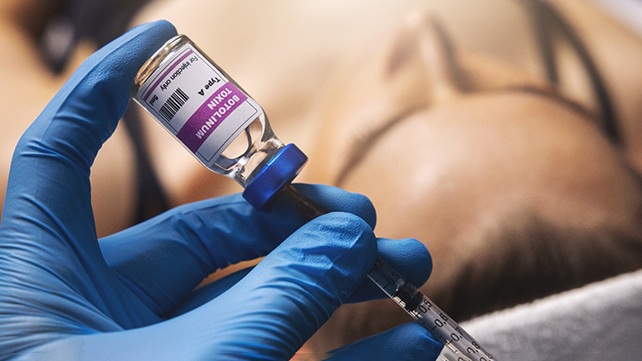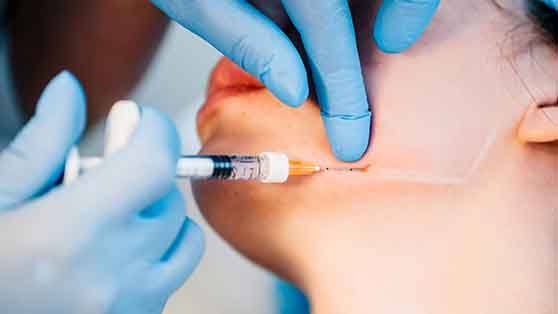BOTOX® – Colchester, VT
Relieve Muscle Tension, Restore Comfort & Reduce Wrinkles
Facial muscle tension can contribute not only to fine lines and wrinkles but also to discomfort, headaches, and jaw strain. Over time, daily muscle use—combined with factors such as stress, teeth grinding, and environmental exposure—can lead to muscle overactivity and fatigue. At Elevate Dental in Colchester, we offer BOTOX® therapy not only to smooth expression lines but also to help relax overactive facial and jaw muscles, promoting comfort, balance, and natural facial harmony. This treatment can be especially beneficial for individuals who experience clenching, tension headaches, or symptoms of temporomandibular joint (TMJ) disorders. By calming targeted muscles, BOTOX® supports muscle recovery, relieves tension, and enhances overall comfort—helping you feel your best every day. In addition to its therapeutic effects, BOTOX® also offers aesthetic benefits, including the softening of expression lines, a more relaxed and refreshed appearance, and in some cases, a slimmer, more defined facial contour when used in the jaw area. Together, these results help restore both comfort and confidence, achieving a naturally balanced look that reflects your inner well-being.
Why Choose Elevate Dental For BOTOX®?
- Dentist Is “Master Injector” of BOTOX®
- BOTOX® for TMJ Treatment
- American Academy of Facial Esthetics (AAFE)
The Science Behind BOTOX® and XEOMIN®

BOTOX® and XEOMIN® are both purified, precisely controlled forms of botulinum toxin type A, a neurotoxin that has been used safely in medicine for decades. These neuromodulators work by temporarily blocking the release of acetylcholine, the neurotransmitter responsible for muscle contraction. By interrupting this signal at the neuromuscular junction, they allow overactive muscles to relax, reducing tension, discomfort, and involuntary movement. Clinically, these treatments are well-established in the management of muscle spasticity, chronic pain, and tension-related conditions, including those affecting the head, neck, and jaw. In therapeutic dental applications, they can be used to relieve clenching, grinding (bruxism), and temporomandibular joint (TMJ) pain, promoting comfort and improved muscle function.From an aesthetic standpoint, the same mechanism helps soften dynamic facial lines—wrinkles formed by repeated muscle movement—resulting in a smoother, more refreshed appearance while maintaining natural expression. XEOMIN® (incobotulinumtoxinA) is a newer-generation formulation of botulinum toxin type A. Unlike BOTOX®, it is “naked” or pure, meaning it contains no accessory proteins. This purified composition reduces the likelihood of antibody formation over time, potentially decreasing the risk of treatment resistance and allowing for consistent, predictable results with repeated use. Both BOTOX® and XEOMIN® are FDA-approved, clinically studied, and medically validated for their safety and efficacy in both therapeutic and cosmetic treatments.
Who Is a Good Candidate for BOTOX®?

Patients who have certain neuromuscular diseases, severe autoimmune diseases, are pregnant/breast-feeding, have skin disorders, or have deep facial scars, may not be the best candidates for BOTOX®. This is why it is crucial that you schedule a consultation. The ideal candidates for BOTOX® tend to be in their late 20s and older.
How BOTOX® Treatments Support Dental Health and Facial Balance

BOTOX® isn’t just for reducing wrinkles—it can also play an important role in dental and facial wellness. Many of the muscles we use to smile, chew, and express emotion are closely linked to jaw function and comfort. By relaxing these muscles in targeted ways, BOTOX® can help relieve tension, reduce pain, and enhance natural facial balance.
Here’s how some common BOTOX® treatment areas connect to dental health:
- Crow’s Feet
Those little lines around the eyes are formed by the muscles we use when squinting or smiling. Treating this area can also ease muscle tension around the temples and upper face, which may help reduce facial strain and headaches that often accompany jaw clenching. - Lines Between the Eyebrows
The muscles between the brows often tighten when we’re stressed or clenching our jaw. Relaxing them can not only smooth frown lines but also ease tension that contributes to TMJ discomfort and tension headaches. - Muscle Spasms
Overactive jaw and facial muscles can lead to pain, tightness, and even limited movement. BOTOX® helps calm these muscles—especially the masseter and temporalis—providing relief from jaw pain, clenching, and grinding (bruxism). - Horizontal Forehead Lines Forehead muscles often compensate when jaw or neck muscles are tight. So, relaxing this area can do more than smooth lines—it can also help restore balance across the face and relieve tension-related headaches.
- Smoker’s Lines Fine lines around the lips don’t just come from smoking—they can also result from repetitive mouth movements or oral habits like clenching. Treating this area softens the lines and helps the lips relax, creating a smoother, more natural look.
- Lines at the Corners of the Mouth When the muscles that pull the corners of the mouth downward become overactive, it can make you look tired or tense. A small amount of BOTOX® can lift and balance the lower face, while also reducing jaw tension and muscle strain.
A More Comfortable, Confident You

By targeting the muscles that affect both oral function and facial expression, BOTOX® helps improve comfort, balance, and appearance—all at once. Whether you’re seeking relief from jaw pain or hoping to refresh your look, this treatment offers a safe, effective, and natural way to support your overall well-being.
The Benefits of BOTOX®

There are a variety of reasons why a patient may want to undergo BOTOX® treatment. Here are just some of its incredible benefits:
Quick Results: BOTOX® is often referred to as a “lunchtime facelift” because it can be completed in as few as 20 minutes. Results become noticeable in just seven to fourteen days.
Non-Surgical: Unlike invasive surgical procedures, BOTOX® is scalpel-free and requires little to no recovery time.
Cost-Effective: BOTOX® is a cost-effective way to enhance your appearance.
Delicate Effects: Lots of patients worry that getting BOTOX® will look obvious. The effects are actually subtle, delicate, and will enhance your youthfulness.
Lasting Results: The effects of BOTOX® typically last between three and six months.
TMJ Treatment: BOTOX® can help to relieve discomfort associated with TMJ dysfunction.
Why See a Dentist for BOTOX?

Dentists are authorized to administer BOTOX® injections to treat a variety of medical and cosmetic issues. Dentists have spent many years studying the ways that facial muscles interact, and they have years of experience administering precise injections. Dr. Kristen has completed over 100 hands-on courses to receive the title of “master injector” for BOTOX®, Dermal Filler, and PDO thread treatments through the American Academy of Facial Esthetics (AAFE). She is currently becoming a mentor of the AAFE, which means you may find her training other professionals to administer Botox!
Jawtox

BOTOX can be used in various parts of the face, including the jaw area! Jawtox, also known as TMJ BOTOX, involves injecting botulinum toxin into the masseter muscles, which are located on the sides of the jaw. Other muscles include the temporalis, sternocleidomastoid (SCM), the trapezius, and other muscles in the back of the occipital region of the head.
Strategic BOTOX injections can help these muscles to relax, leading to more comfort in the TMJ joints, head, and neck. A fortunate byproduct, some patients with strong bulky muscles see a slimmer facial appearance over time. For people with symptoms of TMJ disorder (TMD), BOTOX not only relieves pain, but also decreases the pressure on teeth, reducing cracking and wear.
Botox® FAQs
Does getting Botox® hurt?
Not when Dr. Kristen does it! Dr. Kristen has the experience from dentistry to be gentle, and she uses pressure point techniques to reduce pain while injecting. On top of that, she uses Comfortox® needles that use micropolishing to create a quadruple bevel for the most comfortable injection possible! While you might experience some slight tenderness, minor swelling, and redness immediately after your treatment, these side effects are expected, minor, and brief.
Can Botox® make my lips look fuller?
Botox® works by preventing the muscles that cause the skin to fold and wrinkle from moving, whereas a dermal filler helps add volume to areas like the lips and cheeks. While Botox® can’t make the lips physically bigger, removing wrinkles from around them will naturally cause them to be more prominent and look more vibrant as a result. Dr. Kristen can also provide a dermal filler for the lips, which usually lasts longer than Botox®.
How can Botox® help with TMJ disorder?
Temporomandibular Joint disorder (TMD) can present itself in different ways depending on the individual. Symptoms include discomfort or soreness of the jaw joint or muscles, headaches or migraines, earaches or ringing in the ears, clicking, popping or grinding noises when you move your jaw, difficulty opening or closing your mouth, jaw locking, and the list continues. Whether due to teeth grinding, a misaligned bite, or facial injury, the joint and surrounding muscles and nerves can sometimes develop strain and pain that radiates throughout the head and neck. When Botox® is injected into overactive or tensed jaw muscles, the muscles relax, which typically helps reduce the pain and soreness. This relief, unlike nightguards, is 24/7 and usually lasts for several months.
Will dental insurance help pay for Botox® from a dentist?
No, dental insurance will not cover Botox® treatment from a dentist. Thankfully, Botox® is very affordable compared to other cosmetic options, and we also offer CareCredit financing for those who would like to space out paying for their care.
